Philippine Sea Turtles Face Critical Threats
Philippine sea turtles, including Hawksbill and Green turtles, are critically endangered due to severe threats like habitat loss and climate change.
Habitat loss has led to a drastic decline in nesting sites, with Hawksbill turtle nesting sites decreasing from 10-15 to just 3-6 in recent years.
Conservation Efforts in Place
To protect these vital nesting grounds, conservation efforts have been implemented. The Turtle Islands Heritage Protected Area is a protected zone that provides a safe habitat for sea turtles to nest.
Community engagement programs educate the public about the importance of sea turtle conservation, encouraging local communities to take action.
Climate-Resilient Hatcheries Improve Hatchling Survival
Initiatives like climate-resilient hatcheries aim to improve hatchling survival rates, which significantly impact population recovery.
By protecting nesting sites and improving hatchling survival rates, these conservation efforts can help shift the trend and recover Philippine sea turtle populations.
Overview of Philippine Sea Turtles
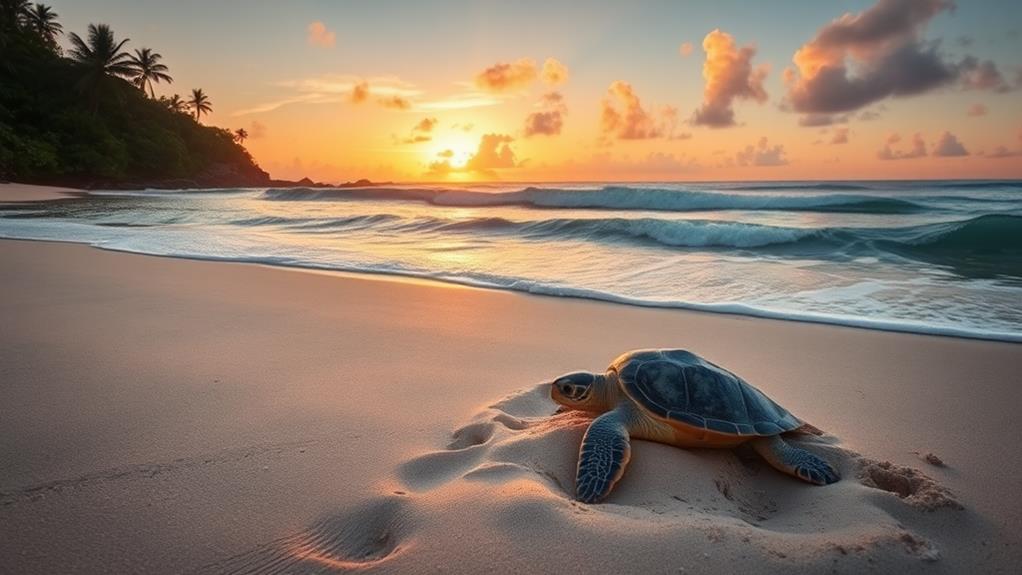
The Philippines is a critical habitat for five distinct species of sea turtles: Green, Hawksbill, Loggerhead, Leatherback, and Olive Ridley.
All five species are classified as endangered on the IUCN Red List, highlighting the urgent need for focused conservation efforts.
The Philippines boasts significant nesting sites, particularly the Turtle Islands Heritage Protected Area, which annually hosts approximately 100,000 eggs.
However, Hawksbill turtles have suffered an alarming 80% population decline over the past decade, primarily due to habitat loss and human disturbances.
Protecting nesting sites is crucial for the survival of these endangered species.
The Philippine Marine Turtle Conservation Program, established in 1979, plays a crucial role in safeguarding these habitats through resource management, research, and community engagement.
By fostering awareness and collaboration, this program aims to mitigate threats to sea turtles and enhance their populations.
Current Population Status
The current population status of sea turtles in the Philippines is alarming, with all five species facing severe threats.
Hawksbill turtles have experienced an 80% decline in their population over the past decade, primarily due to human development and climate change. This decline is evident in the reduction of their nesting sites from 10-15 sites between 2000-2005 to only 3-6 sites by 2018.
Olive Ridley turtles are also threatened, as their nesting habitats are increasingly affected by coastal erosion and rising sea levels, resulting in higher rates of egg spoilage.
Despite these challenges, ongoing research initiatives have made progress in monitoring and understanding these endangered species. A national database has identified over 1,100 individual turtles, highlighting efforts to track and study these species.
The Turtle Islands Heritage Protected Area stands out as a critical site for sea turtle conservation. As the largest nesting area in Southeast Asia, it hosts approximately 100,000 turtle eggs laid annually. This emphasizes the region's importance for sea turtle conservation.
Immediate and effective conservation actions are necessary to prevent further decline in the population. Without these efforts, the current population status of these magnificent creatures may continue to decline, threatening their existence for future generations.
Major Threats to Sea Turtles
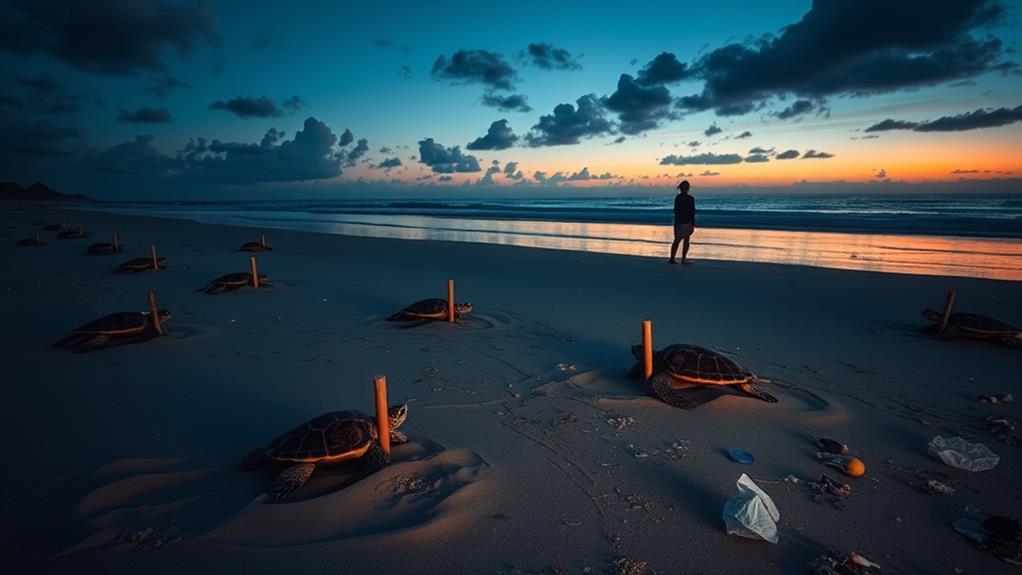
Major Threats to Sea Turtles in the Philippines
Coastal Erosion: The degradation of nesting sites due to development and pollution poses a significant threat to sea turtles.
Loss of habitat for nesting turtles is a direct consequence of coastal erosion, making it difficult for turtles to find suitable nesting grounds.
Poaching: The illegal harvesting of adult turtles and eggs is another major threat.
Direct reduction in population numbers results from poaching, as it removes individuals from the population and prevents them from reproducing.
Climate Change: Rising sea levels and increased sand temperatures due to climate change have a devastating impact on sea turtles.
Decreased hatching success for turtle eggs is a consequence of climate change, as the altered environmental conditions make it difficult for eggs to incubate successfully.
Habitat Degradation: Pollution from waste and chemicals in marine areas affects the overall health of turtle populations.
Affects overall health of turtle populations by exposing them to toxic substances, which can lead to illness, injury, or even death.
These threats have contributed to the decline of endangered species, particularly the hawksbill turtles.
Hawksbill turtles' nesting sites have reduced from 10-15 to just 3-6 between 2000 and 2018, largely due to human activity and climate-related flooding.
Establishing marine protected areas may help, but addressing these major threats is crucial to ensure the survival of sea turtles.
Conservation Efforts in the Philippines
Conservation Efforts in the Philippines
The Philippines is home to five endangered sea turtle species: Green, Hawksbill, Loggerhead, Leatherback, and Olive Ridley turtles. To protect these species, significant conservation efforts are underway.
Task Force Pawikan and TIHPA
In 1979, Task Force Pawikan initiated conservation efforts, focusing on enhancing marine turtle conservation and restoring dwindling populations.
The Turtle Islands Heritage Protected Area (TIHPA) is a key area for these efforts, recognized as Southeast Asia's largest nesting site. Around 100,000 turtle eggs are laid annually, mainly by Green turtles.
Research Initiatives
Research projects, such as the Panglao Turtle Research Project, have made significant strides in identifying local turtle populations.
180 individual turtles have been documented, informing effective conservation strategies.
Philippine Marine Turtle Conservation Program
The Philippine Marine Turtle Conservation Program, under the Department of Environment and Natural Resources (DENR), emphasizes resource management, research, and public education.
The program aims to bolster turtle conservation work through these efforts.
Protected Areas
Protected areas play a critical role in ensuring the survival of these species.
By implementing strict guidelines and monitoring, the Philippines aims to create a safe environment for nesting and foraging.
Through these comprehensive conservation efforts, the country seeks to secure a future for its cherished sea turtles.
Role of Community Engagement
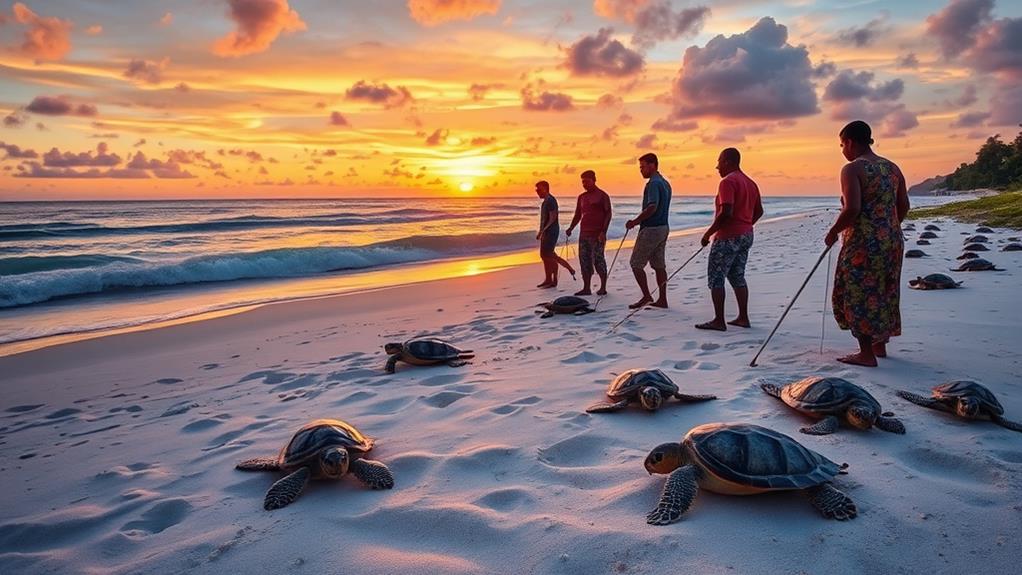
Community Engagement is Crucial for Sea Turtle Conservation
Community engagement plays a vital role in the conservation of sea turtles in the Philippines. Local involvement is essential for effective protection measures, and trained local volunteers actively conduct nightly patrols during hatching seasons, significantly safeguarding nesting sites from threats.
For instance, the Coastal Underwater Resource Management Actions (CURMA) program has successfully transformed former poachers into conservation allies, demonstrating the impact of community participation on marine turtle populations.
Education and Awareness Foster Responsibility
Educational outreach programs have engaged 100 local students, instilling a sense of responsibility towards marine resources and fostering awareness within local communities.
Collaborative efforts between these communities and NGOs have led to the establishment of critical habitats, enhancing monitoring of nesting sites and contributing to increased turtle nesting rates during conservation initiatives.
Eco-Tourism Initiatives Provide Economic Incentives
Eco-tourism initiatives provide economic incentives that encourage local families to participate in conservation activities, highlighting the positive impact of community engagement on both biodiversity and local livelihoods.
By involving local communities in the conservation of marine turtles, you not only protect these endangered species but also empower individuals to take ownership of their natural resources, ensuring a sustainable future for both turtles and the communities that depend on them.
Research Initiatives and Findings
Research initiatives have transformed the conservation landscape for sea turtles in the Philippines.
The Panglao Turtle Research Project, launched in December 2019, has identified 180 individual marine turtles and provided training to local communities, enhancing conservation efforts.
Similarly, the Apo Island project has documented over 200 individual turtles, predominantly green turtles, highlighting the importance of local marine protected areas in safeguarding these species.
Weekly monitoring of potential feeding grounds aids in identifying key habitats crucial for conservation strategies. The Cebu Turtle Research and Conservation Project focuses on this monitoring, which helps identify critical areas for conservation.
Critical nesting beaches for Olive Ridley turtles have been spotlighted. The Northwestern Palawan Turtle Nesting Project has established local hatcheries to protect these populations from threats like beach development and climate change.
Recent scientific research has added 1,100 individual turtles to the national database. The deployment of satellite tags on three adult turtles has provided valuable data for tracking movements, fostering a deeper understanding of their behavior.
These collaborative efforts are vital in addressing the challenges faced by critically endangered marine turtle species and ensuring their survival in the Philippines.
Importance of Nesting Sites
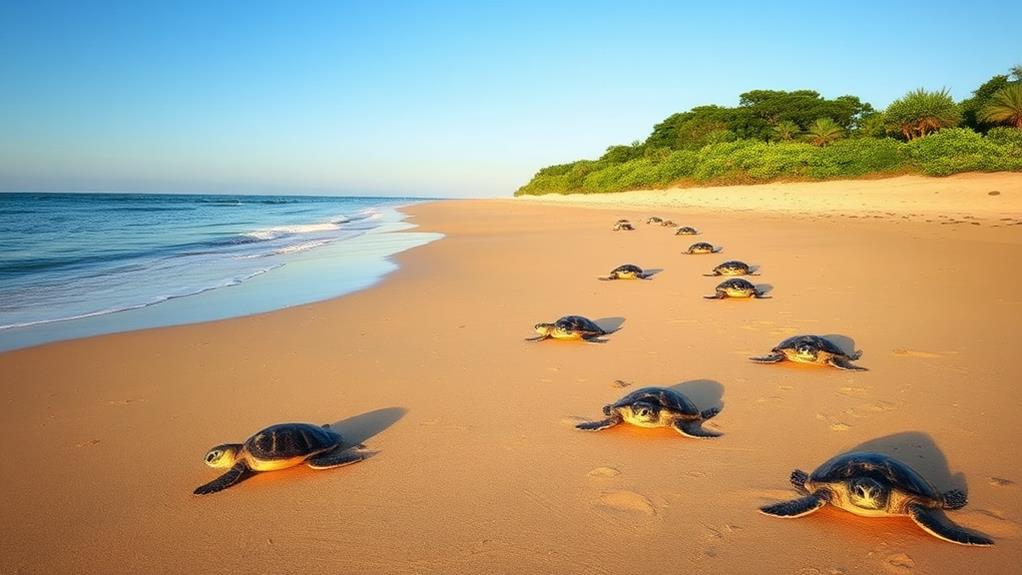
Nesting Sites: Crucial for Sea Turtle Survival
Sea turtles rely heavily on nesting sites, where females lay their eggs, to survive. Each nest contains around 100 eggs, making these sites vital for species like the Olive Ridley and Hawksbill turtles. The Philippine archipelago is home to significant nesting areas, with the Turtle Islands Heritage Protected Area hosting around 100,000 eggs laid annually.
Threats to Nesting Sites
Nesting sites are increasingly threatened by coastal development and climate change. For instance, Hawksbill turtles have seen a drastic reduction in nesting sites, dropping from 10-15 sites in 2000-2005 to only 3-6 sites by 2018. This alarming trend highlights the urgent need for conservation efforts to protect these vital habitats.
Conservation Initiatives
Effective conservation initiatives aim to increase the survival rates of eggs and hatchlings. Establishing hatcheries is one such initiative, targeting a 30% increase in saved turtle nests. Other conservation actions include:
| Threats to Nesting Sites | Conservation Actions |
|---|---|
| Coastal development | Establish protected areas |
| Climate change | Create hatcheries |
| Pollution | Conduct community awareness |
| Predation | Monitor nesting populations |
| Habitat destruction | Implement restoration projects |
Climate Change Impacts
Climate change poses a significant threat to the survival of sea turtles in the Philippines. Rising sea levels, projected to increase by 20 centimeters (8 inches) annually, lead to the flooding of critical nesting sites, resulting in significant egg loss and jeopardizing endangered turtle populations.
Increased sand temperatures reduce hatching rates, directly threatening turtle populations. Warmer sand temperatures can cause embryos to develop more slowly or not at all, leading to reduced hatchling numbers.
Coastal erosion exacerbates habitat loss, undermining prime nesting locations along the coastlines. Eroding coastlines can result in the loss of nesting sites, forcing turtles to find new locations, which may not be suitable for nesting.
Extreme weather events, like intensified typhoons, destabilize nesting sites and further endanger sea turtles. Typhoons can destroy nesting sites, wash away eggs, and disrupt the natural habitat of turtles.
Altering temperature and humidity levels can skew gender ratios of hatchlings, risking genetic diversity. Temperature and humidity changes can influence the sex of hatchlings, potentially leading to an imbalance in the population's gender ratio.
Flooding of nesting areas can lead to breeding failures and population declines. Flooding can cause eggs to be washed away or destroyed, preventing successful breeding and reducing turtle populations.
Addressing these climate change impacts is crucial for protecting sea turtles. Conservation efforts must focus on preserving nesting habitats and mitigating the effects of climate-induced environmental changes to ensure the survival of these vulnerable species.
Citizen Science Contributions

Citizen Science Contributions to Sea Turtle Conservation
Citizen science has significantly contributed to the conservation of sea turtles in the Philippines by engaging local communities in data collection and monitoring efforts.
Photographic submissions from the public have proven invaluable at key sites like El Nido and Apo Island, enhancing our understanding of sea turtle populations.
The Panglao Turtle Research Project is a prime example, where community involvement led to the identification of 180 individual turtles. This local engagement not only aids in tracking but also fosters a sense of responsibility among participants.
Over 100 local students have participated in outreach programs, raising awareness about marine ecosystems and the importance of conservation efforts.
Community members' participation in nightly patrols during hatching seasons plays a crucial role in monitoring and protecting turtle nests, directly contributing to the conservation of endangered species.
The integration of citizen science has added 1,100 individual turtles to the national database, showcasing its effectiveness in assessing and tracking turtle populations across the Philippines.
Hatchery Construction Initiatives
Constructing hatcheries is crucial for the conservation of sea turtles in the Philippines. The Wildlife Adaptation Innovation Fund, in collaboration with the Large Marine Vertebrates Research Institute and Duli Beach Resort, is building four climate-resilient hatcheries across nesting beaches in El Nido.
These hatcheries are designed to combat environmental threats, ensuring the safety of turtle eggs. Concrete design allows them to withstand severe weather conditions, as they're partially buried underground.
Additionally, they're equipped with real-time monitoring systems, including weather stations and sensors, to optimize incubation conditions.
The hatcheries aim to increase the survival rate of turtle nests by at least 30%. To achieve this, local community members are trained to conduct nightly patrols during hatching seasons from November to February.
This initiative not only supports the conservation of vulnerable sea turtle populations but also involves the local community in the conservation effort.
Education and Awareness Programs

Education and Awareness Programs: A Vital Component of Marine Turtle Conservation
Education and awareness programs are crucial for enhancing public understanding of marine turtle conservation in the Philippines. Implemented across 24 provinces, these initiatives utilize various media channels to reach diverse audiences.
Program Elements and Their Impact
Educational Materials: The distribution of 3,000 brochures and T-shirts raised awareness on turtle protection among communities near turtle habitats. This effort increased public knowledge of marine turtle conservation.
Training Workshops: Skills development for local staff and community members enhanced conservation effectiveness. This training empowered local communities to take an active role in conservation efforts.
Student Involvement: Over 100 students engaged in activities, instilling environmental stewardship. By engaging students, these programs fostered a sense of responsibility for marine turtle conservation.
Media Outreach: The use of social media and local events broadened the reach of conservation messages. This outreach effort increased public awareness of marine turtle conservation.
Collaborative Efforts: Partnerships with local organizations and schools strengthened community ties and support. These partnerships enabled more effective conservation efforts.
Empowering Communities, Securing a Safer Future
These education and awareness programs not only educate but also empower communities to take an active role in marine turtle conservation.
Success Stories and Achievements
Community Engagement and Targeted Initiatives Drive Marine Turtle Conservation Success in the Philippines
The Philippines has made significant strides in marine turtle conservation, thanks to community engagement and targeted initiatives. These efforts have led to various successful programs and practices that have emerged in recent years.
CURMA Program Achievements
The Coastal Underwater Resource Management Actions (CURMA) program has recorded 75 nests and nearly 9,000 hatchlings released last season. This achievement demonstrates the effectiveness of community-led conservation efforts.
Increased Monitored Nesting Sites
Community-led initiatives have led to an increase in monitored nesting sites, showcasing local commitment to conservation efforts. This increase is a direct result of community engagement and participation in turtle conservation.
Establishment of Critical Habitat
In 2012, a 612-hectare critical habitat for hawksbill turtles was established, facilitating species monitoring and protection with local volunteer involvement. This habitat provides a safe environment for hawksbill turtles to thrive.
Climate-Resilient Hatcheries
The construction of four climate-resilient hatcheries in El Nido aims to increase saved turtle nests by at least 30%, which is crucial for preserving turtle populations against climate challenges. These hatcheries provide a safe haven for turtle eggs and hatchlings.
Increased Hatchling Survival Rates
Reports indicate increased hatchling survival rates and signs of population recovery among olive ridley turtles at CURMA's hatchery in San Juan. This improvement is a direct result of dedicated community engagement and innovative conservation strategies.
These success stories demonstrate how turtles lay their eggs in safer environments, thanks to dedicated community engagement and innovative conservation strategies, ultimately enhancing the prospects for these endangered species.
Future Directions for Conservation
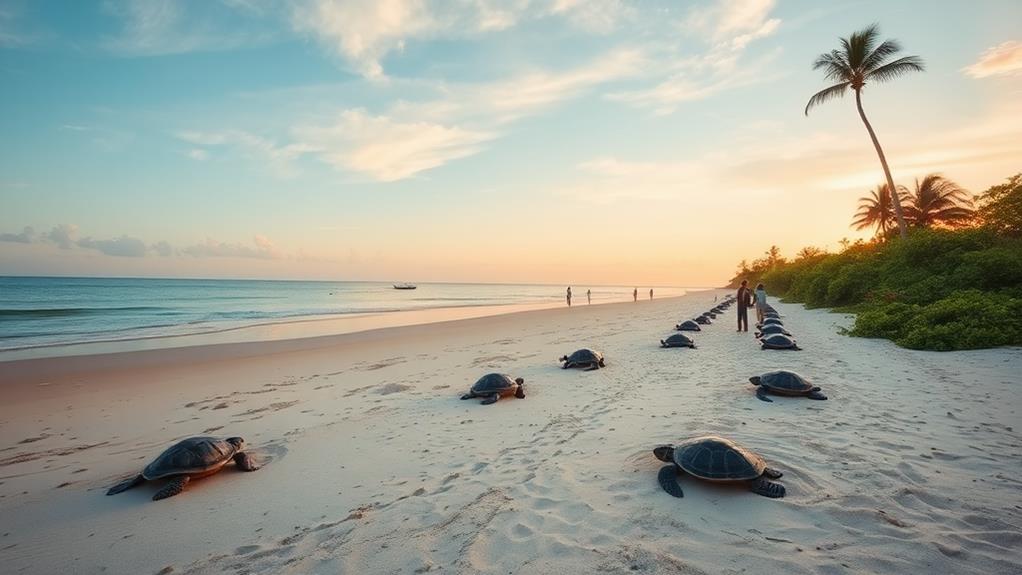
Philippine Sea Turtle Conservation Efforts Expand and Intensify
Future conservation initiatives for Philippine sea turtles focus on expanding protected nesting sites and enhancing community involvement. The construction of four climate-resilient hatcheries in El Nido, supported by WWF's Wildlife Adaptation Innovation Fund, aims to provide safer environments for turtle nests, crucial for population recovery.
Community Engagement is Key
Training local members to conduct nightly patrols during primary hatching seasons fosters environmental awareness and encourages direct participation in protecting turtle nests.
The Marine Turtle Conservation Program plans to declare the Turtle Island Group as a National Heritage Park, aspiring for ASEAN Heritage Park status to strengthen regional cooperation in turtle conservation.
Research and Monitoring
Research initiatives are vital, aiming to monitor and assess turtle populations, with the objective of increasing saved nests by at least 30%. This requires collaboration with communities and updated sustainable tourism guidelines.
Long-term strategies must balance local fishing practices with turtle protection, necessitating partnerships with NGOs and government entities to sustain conservation efforts amid economic pressures.
Securing the Future of Philippine Sea Turtles
Through these collective actions, the future of Philippine sea turtles can be secured, ensuring their survival for generations to come.
Questions and Answers
Are Turtles Protected in the Philippines?
Turtles are protected in the Philippines. The Philippine government has implemented measures to conserve turtle habitats and nesting behavior. This recognition is crucial, as turtles play a vital role in maintaining healthy marine ecosystems.
Conservation challenges persist, however, due to poaching and habitat loss. Poaching, for instance, threatens the survival of turtle species, as their eggs and meat are in high demand.
Habitat loss, on the other hand, destroys the natural environments where turtles nest and live.
Local awareness is crucial in combating these threats. Communities near turtle nesting sites can significantly contribute to conservation efforts by monitoring and protecting these areas.
What Is the Philippine Marine Turtle Conservation Program?
The Philippine Marine Turtle Conservation Program aims to protect turtle nesting sites and enhance marine ecosystems. The program works to educate local communities about the importance of marine turtle conservation and the role that they can play in protecting these species. Additionally, the Philippine Marine Turtle Conservation Program collaborates with government agencies and other organizations to enforce laws and regulations that safeguard nesting sites and turtle populations. These efforts are part of the broader conservation initiatives in the Philippines, including Philippine crocodile conservation efforts, to preserve the country’s rich biodiversity.
This program focuses on habitat restoration, which involves rehabilitating damaged or degraded habitats to create a safe environment for marine turtles to thrive. For instance, it restores mangrove forests, which serve as crucial breeding and nesting grounds for these turtles.
The program also engages local communities in awareness campaigns, educating them about the importance of marine turtle conservation. This helps to foster a sense of responsibility among residents, encouraging them to adopt sustainable practices that support turtle conservation.
Additionally, the program manages sanctuaries where turtles can safely nest and hatch without human disturbance. These sanctuaries are protected areas that provide a safe haven for turtles to breed and lay eggs.
Research is also a key component of the program, which helps scientists to better understand marine turtle behavior, habitat preferences, and population dynamics. This research informs conservation efforts, ensuring that they're targeted and effective.
Ultimately, the Philippine Marine Turtle Conservation Program secures the future of marine turtles while promoting sustainable practices within local communities.
Are Sea Turtles Protected by the Endangered Species Act?
Yes, sea turtles are protected by the Endangered Species Act (ESA). This law safeguards their habitats, which are essential for their survival in marine ecosystems. Specifically, the ESA protects the areas where sea turtles nest and forage for food.
The ESA helps mitigate threats to sea turtles. Climate change and human activities, such as pollution and coastal development, can harm sea turtles. The ESA enforces regulations to reduce these threats and promote the recovery of endangered sea turtles.
The ESA maintains the balance of marine ecosystems. By protecting sea turtles and their habitats, the ESA helps preserve the delicate balance of these ecosystems. This is crucial for the survival of many marine species, including sea turtles.
What Can People Do to Protect Sea Turtles and Other Endangered Species?
Community Involvement in Habitat Preservation
Sea turtles and other endangered species can be protected through community involvement in habitat preservation initiatives. For instance, participating in local beach cleanups helps remove trash and debris that can harm these animals.
Additionally, supporting organizations that restore natural habitats, such as mangrove forests or coral reefs, provides a safe environment for these species to thrive.
Responsible Tourism
Engaging in responsible tourism is another way to protect sea turtles and other endangered species.
Choosing eco-friendly travel options that support conservation efforts helps fund projects that promote wildlife conservation. For example, selecting tour operators that follow sustainable tourism practices and support local conservation initiatives can make a significant difference.
Education and Advocacy
Participating in educational programs helps raise awareness about wildlife issues and promotes conservation efforts.
Advocating for wildlife rehabilitation projects also supports the recovery of injured or stranded animals, increasing their chances of survival.
Furthermore, reporting sightings of sea turtles and other endangered species to local authorities or conservation groups enhances research and monitoring efforts.
Volunteering and Research
Volunteering for local conservation groups and participating in research projects helps collect valuable data on these species.
This information is crucial for developing effective conservation strategies and ensuring these species receive the attention they need to thrive in their natural environments.